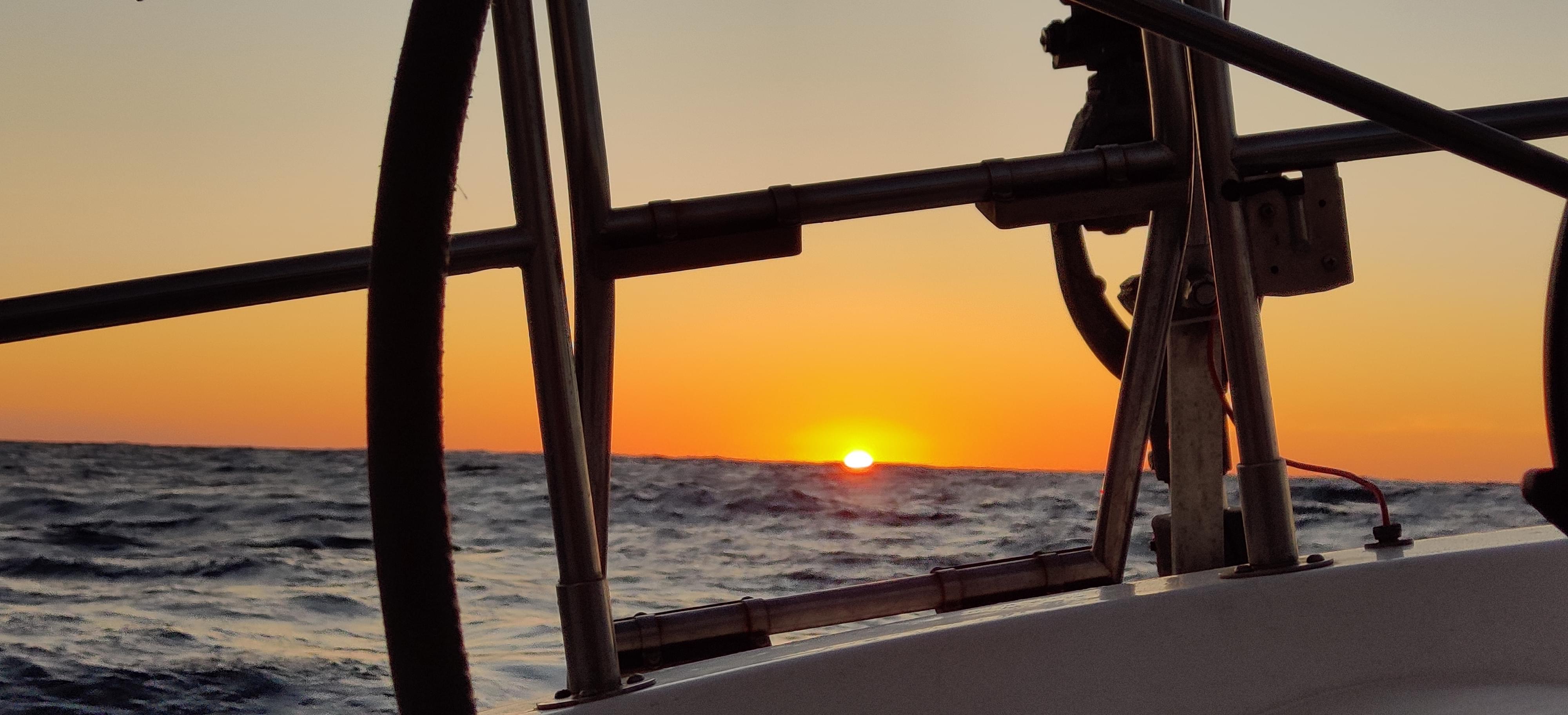Let's say we are not superstitious or let's pretend we didn't know the sailor's superstition... Our weather window for crossing from Baja California to mainland Mexico happened to be on a Friday, so we cast off on a Friday!
Sailors from various places in the world would do anything to prevent this from happening: casting off on the Thursday at 23:59 or on the Saturday 00:01, or just advance or postpone their departure by a day. The superstition says that Poseidon may be pissed off if you cast off on a Friday! Hoping the Sea God wouldn't try novice passage makers too hard, we went, got our lot of challenges but nothing terrible happened to us. We had taken our precautions - the weather window had been approved by "the" person in charge of announcing the forecast of the Sea of Cortez on the long range radio (SSB) and turned out to be chatting with Jeff, our friend from Isla San Francisco, every morning- but we still had to face a few challenges just to get on the go.
Challenge 1: the breakfast Plans had been made to depart early as we had to make a little detour to get the latest forecast (and internet). We had therefore decided to cast off as soon as possible and have breakfast underway as we'd motor to the channel between the mainland and the islands where we hoped for internet. But, long story short, we still had things to take care of before leaving since we had arrived at night the day before and I had had a bad night (I won't regret the Coromuels once we leave this area!) so we altered plans and had breakfast at anchor in Playa de la Bonanza. The view from the cockpit was lovely (always cool to discover the scenery when you emerge in the morning) but the clock was ticking...
Challenge 2: the big jib! Among the things we still had to take care of before departing was a headsail change! Nothing complicated most of the time... Before arriving to La Paz a month or so ago, aware of the variable winds in the area, we had switched our beloved working jib to our massive genoa. It had turned out to be a good choice as it had allowed us to make good speeds both in light and in lazy conditions (jib alone as distances would sometimes be too short to justify the effort of hoisting the main). However, this giant sail would have us easily overpowered and we really wanted to switch back to our more manageable working jib for the passage. On top of everything, we weren't sure if the big genoa would give much more speed on a downwind course, which was our expectation for the trip. From there, the plan was to take the sail down, flake it on the deck as it'd go down, roll it to put it in its bag and then unroll and hoist the working jib. That's for the theory. Yalçın had offered to do it underway, I had preferred to do it at anchor. The latter wasn't the best idea but I'm still unconvinced whether the former would have been any easier. What happened is that the big jib powered the boat which bow was blown off by the wind and the boat was slowly sailing as we tried to douse the large sail. We had to wrestle to take it down and tie it on the deck to prevent it from flying away - easier said than done as that jib is strongly overlapping and therefore hard to flake on the deck. Anyway, with patience and more or less productive discussions, we won the fight and the sail went back into its bag. Unfortunately, as it ended up way bulkier than when we had taken it out from its bag (we had folded it thoroughly on the dock in Berkeley, it was as flat as it gets, almost ironed!) and wouldn't fit in its assigned spot. After setting up the good old (actually newer) working jib on the furler, the genoa found a temporary home in the shower and we were ready to not hear about it for a little while!
Challenge 3: the mood We were getting quite late on our tentative schedule. The jib wrestling had taken a toll on our confidence and we still had to take care of making the boat passage ready. On top of it, I guess we were both unconsciously a little nervous about our first passage and had a hard time coordinating about working efficiently together. Trying to be optimal, we ended up having to discuss even more to get back to the same page as we got ready to cast off.
Challenge 4: one last bit of internet Eventually, around noon, we weighed anchor from Playa de la Bonanza. Bye bye Isla Espiritu Santos! But we weren't bound for Mazatlan yet: We had decided to get a last minute forecast right before departure to make sure we wouldn't get any bad surprise in the middle of the Sea. Based on Navionics that seem always iffy about internet coverage, we had hoped once more to get an internet that didn't exist. Getting internet involved a little detour to the San Lorenzo channel on the way to La Paz. After motoring for a bit, the magic happened and we finally got reconnected to these invisible links that connect us with society, for better or for worst. On the "better" side, we got a detailed updated forecast for sustained winds until the middle of the second night of cruising and we were able to catch-up with family and friends after more than one week mostly offline. At 2PM, we hoisted the main, said goodbye to our relatives and embraced our faith of two days and two nights on our little Tire-Bouchon boat.
Challenge 5: above or below the island? Yay, we were on our way!... But which way? Passage making is usually sailing straight from one point to the other in an empty ocean. But we were in a sea and we had an island dead ahead of us! Was it faster to go North or South of it? Yalçın was leaning to go to the South, I was leaning for North. None of us had strong arguments, we went South: the course was more comfortable and we saw mantas again, which led to the next challenge...
Challenge 6: capturing the jump of a ray with a zoom lens camera Once again, easier said than done! There were many of these fish with wings and they were jumping, sometimes twice in a row, more or less close to the boat. Yet, capturing them was extremely difficult, either you wouldn't get any in a very zoomed in field of view or you wouldn't be able to distinguish the animal in a zoomed out setting. Tired of missing all the beautiful jumping action, I left the camera with Yalçın who was more patient and overall more talented at spotted sea action: he got one good one!
Challenge 7: regular winds! We have been spoiled on the Pacific coast of Baja with the consistent 15 to 20 knot winds which would carry us at 5-6 knots average. For a moment, after dinner, we thought such beautiful conditions were on the menu for the night. We were making good progress and reefed as it had become our habit on the other side of the peninsula when the night would come: a matter of safety and comfort. We were starting to take shifts and I was on watch. Not more than 15 minutes after reducing sail, the wind dropped to the lighter speed which were going to be the norm on this passage and I had no choice but to do the opposite manoeuvre and unreef: a lot of sweat for nothing!
Challenge 8: a full day without any land! This one was actually quite cool! From the moment Yalçın took his shift to see the sun rise on Saturday to the moment when we both watched the sun set, we only saw blue around us from the sea to the empty horizon and the sky. The sun strength was forcing us to hide in the little shade the dodger would offer or inside, still taking turns. When the time would come on Sunday, we would notice more boat lights in the horizon at first, then see a bird, smell the land (this particular odor of ground that comes way before the first sight!), have a fly in the cockpit and then see the land.
Challenge 9: AIS or spotting vessels at night Our AIS (or Automatic Identification System) receiver gets a radio signal from AIS transmitting vessels that gives us their names, positions, speeds and courses. Most commercial vessels transmit and since you can set an alarm if the vessel is going to come to close to yours, it's an excellent navigational aid. That first night, we both experienced picking up a vessel visually way before it appeared on the AIS screen: a good reminder that nothing replaces a good watch! One of the vessel we saw that way was the Baja Star, the ferry that connects La Paz to the mainland.
Challenge 10: the lost blogposts A good time to write all these blogposts is during the watches. It's an active activity, which, for the second shift at least, is enjoyable as it is sometimes hard to stay awake listening, watching or reading something. We had quite a bunch already written but still had to select and add the picture, proof-read and write the latest ones. However, when I opened the WorldPress app to look into my drafts, there were none! Vanished, gone, disappeared... from anywhere I could look: in the app, online, on Yalçın's app! Clearly, something unexpected and unfortunate had happened while my phone synchronized with the world wide web in the San Lorenzo channel! Instead of catching up on writing, I had plenty of time to wonder whether I would try to rewrite what I had lost or not, if nothing reappeared when I'd reconnect my phone... I have seen better thoughts!
Challenge 11: the dishes The seas were rather flat - that's the beauty of being off chart for the ocean swell (soon to change!) - so we were both able to cook a little, despite having killed our sea legs in the flat anchorages of Eastern Baja. But when you set off for a longer passage, cooking isn't enough, the sink also fills as you eat and one has to do the dishes. Yalçın, whose sea legs were the strongest, took that on himself.
Challenge 12: the squids on the deck You may know my love for sea food by now (irony!)... Now imagine the perspective of ending up with such an animal in the face while smooth sailing! We got two that landed on the deck: beurk!
Challenge 13: the sound of the goose neck Contrasting with our previous experiences, I was impressed at the silence in the cabin. Of course, it wasn't a full silence but the unmistakable water streams on the hull, the loud noise of the cabin wood creaking, all those sounds had disappeared, at least for now. I guess Tirb was having a less intense ride in these dull conditions. The problem though is that the few sounds that remained took all the space. Or had we forgotten about them after all this time? The rudder post was loud, likely asking for its greasing (which meant no big deal). The other, and more nerve-wracking sound noise was coming from the mast itself. It took both of us to conclude it was probably the goose-neck which has two screws which need tightening. Before we were able (and decided) to take this main sail down, with the winds dying out, the sail was flapping on each little beam wave and, each time, "clang" in the goose-neck!
Challenge 14: the duration For both of us, time felt long. More than our sea legs, we had lost the habit of being at sea. We both felt that this crossing would have been a piece of cake after our trip down Pacific Baja, but this month in the La Paz area had turned the Bay area sailors into marine explorers and cruisers. With the wind on the verge of extinction for half a day and dying out at the end, the time felt quite long and we were ready to arrive way before the time had come, especially as our worries for the goose-neck grew.
Challenge 15: resting in Venado Island Because we had been waiting for it, arriving wasn't a challenge in itself and we were curious and happy when we saw the "skyline" of Mazatlan appear. We had chosen the Venado Island anchorage as a landing point since it was supposed to offer a nice viewpoint on the city front and it wasn't far from the marina harbor. On the downside, it could be rolley because both exposed to the swell and to the wake of power boaters and jetskis. But how bad could it be? We were used to Pacific Baja rolley anchorages for the former and could we still be surprised after Cabo for the latter? The answer is we could! There was not less than 20 boats going around this anchorage, all with their music (sometimes live) and with their lot of tourists, swimming, jetskiing etc... Not ideal to catch up on sleep too say the least!
But I guess that was our last challenge, for a little while at least!
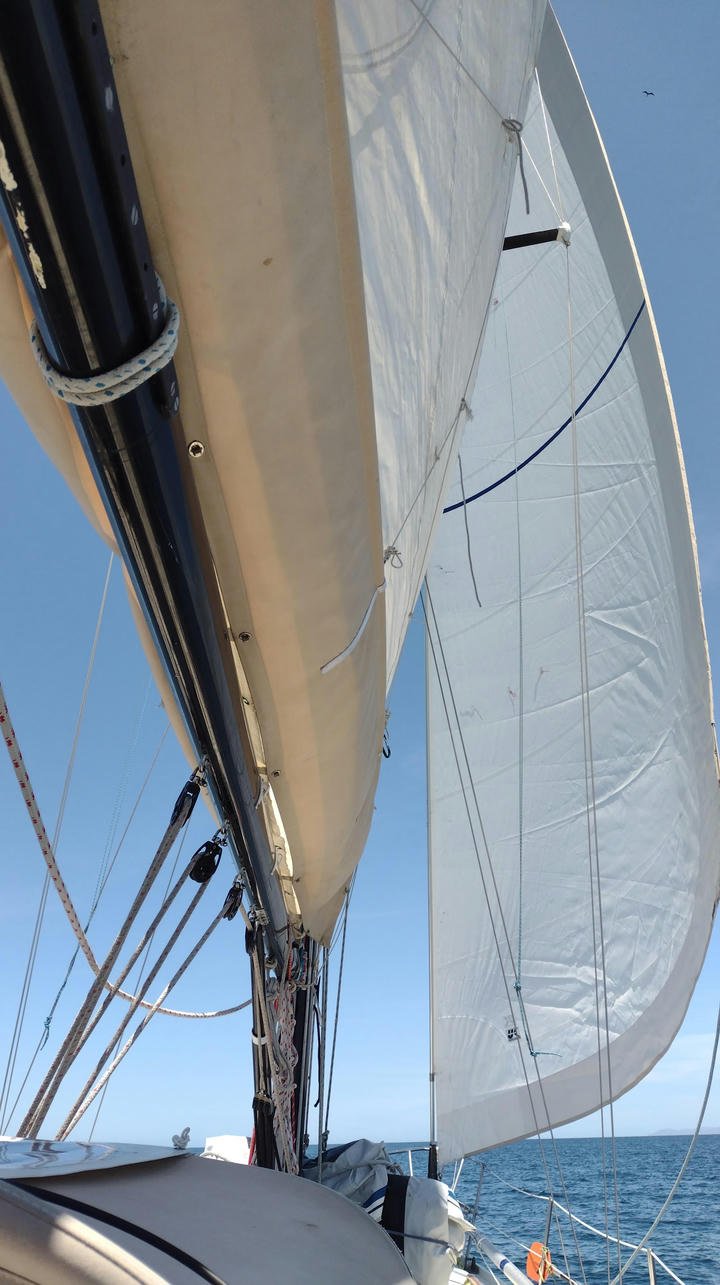
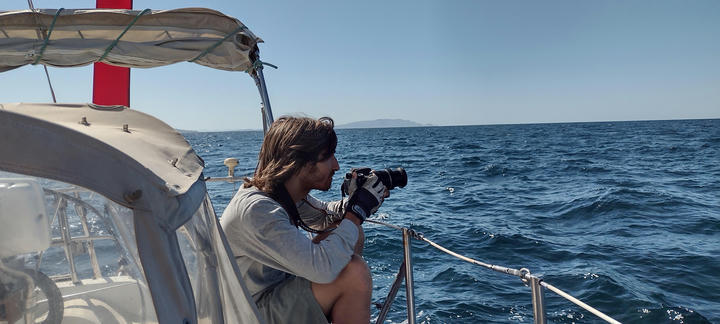
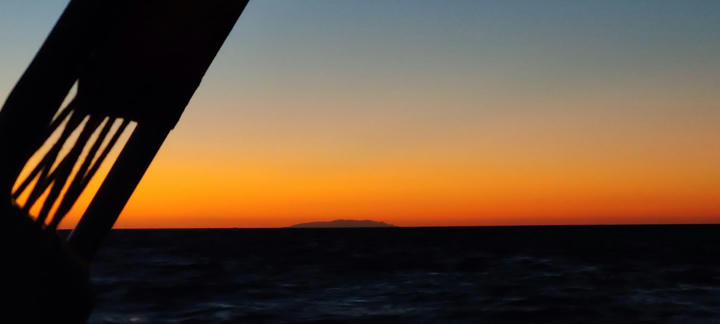
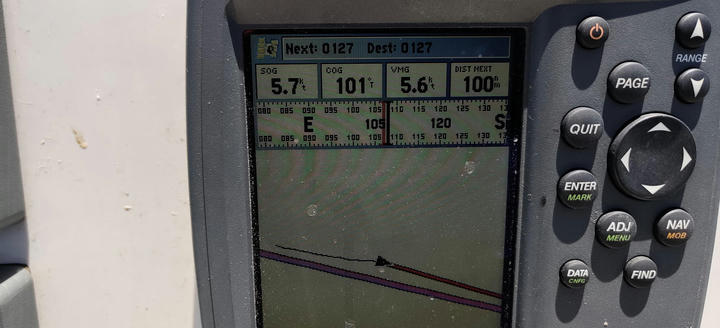
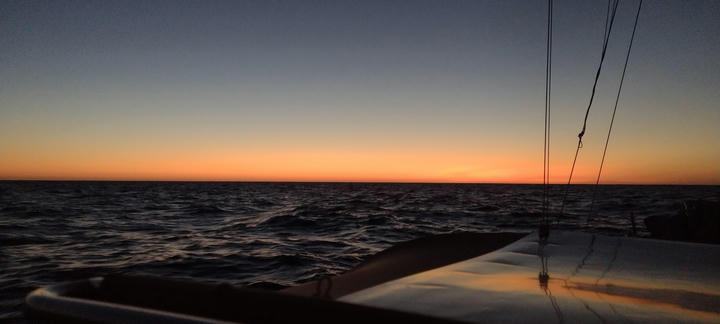

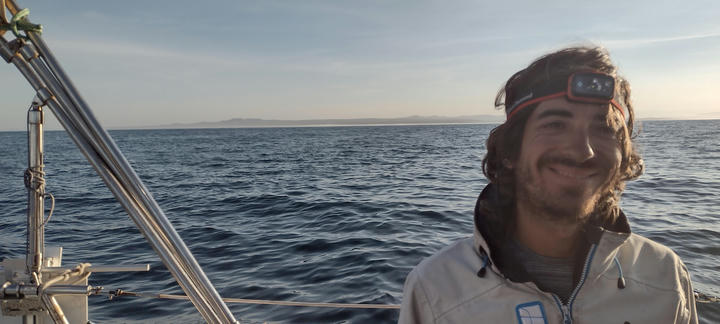
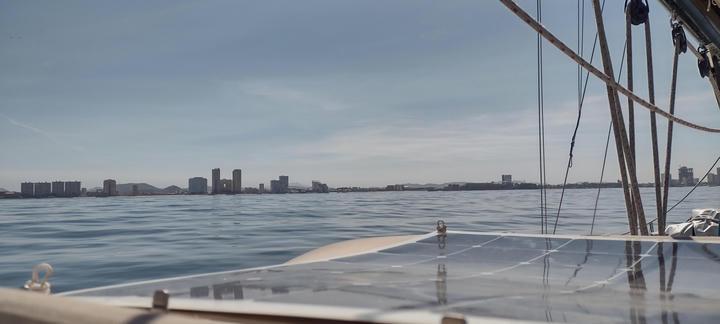
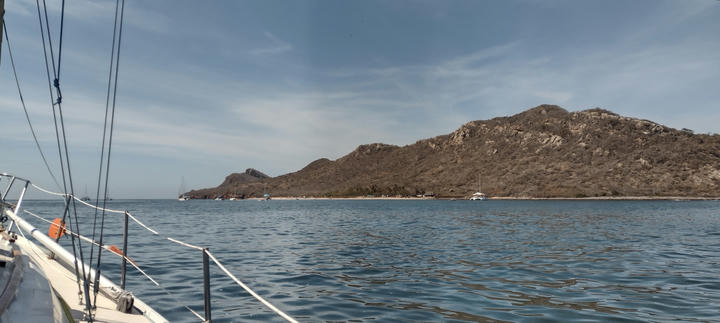
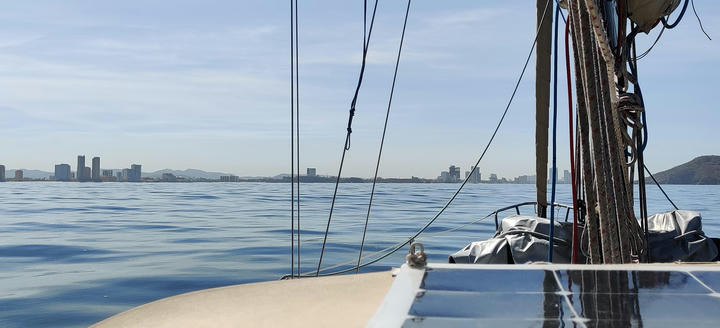
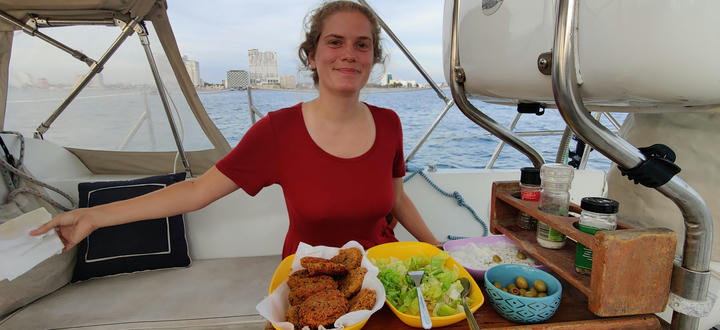
P.S.: These are the challenges but don't get me wrong, there was some good as well: the full moon gave us daylight during most of the night which was really appreciable, it felt also good to be on the move again, the mantas and wildlife were still incredible and the taste of accomplishment of these falafels on Sunday was priceless!
Crossing of the Sea of Cortez from Friday, April 23rd to Sunday, April 25th
